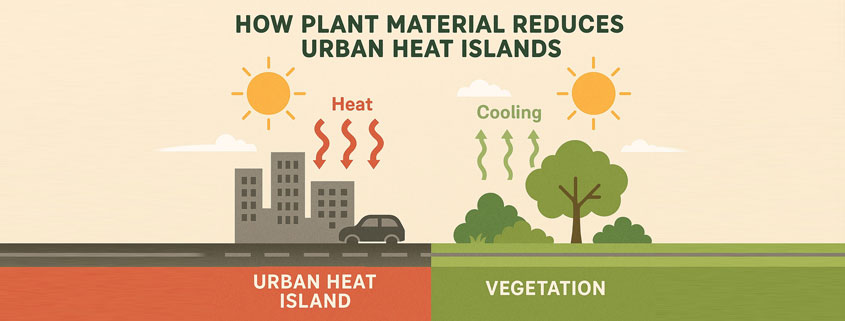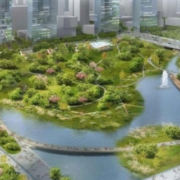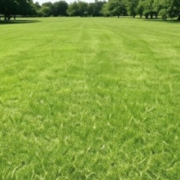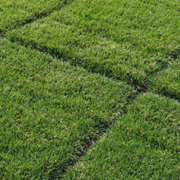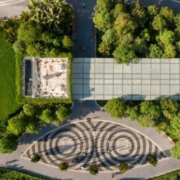Every Drop Counts
Every Drop Counts in Healthy Green Spaces
Healthy green landscapes—parks, sports fields, home lawns, gardens, and urban forests—perform essential environmental functions like mitigating urban heat, slowing stormwater, sequestering carbon, producing oxygen, preventing soil erosion, and filtering pollutants from the atmosphere and water ways.
Research Highlights
- Healthy green landscapes are critical to the built environment because they provide numerous ecological, social, and economic benefits.
- Vegetation reduces the urban heat island effect by providing shade and facilitating evapotranspiration from plants, leading to cooler urban environments.
- Healthy green spaces capture carbon dioxide from the atmosphere and produce oxygen during the process of photosynthesis.
Water conservation and the maintenance of healthy green landscapes may be perceived as conflicting goals. However–when managed properly–healthy green landscapes make significant contributions to the environment while using water efficiently.
The key to these contributions is balance. Balancing efficient water use and healthy green landscape management helps to sustain these vital green spaces and conserves water resources.
The Importance of Healthy Green Landscapes
Healthy green landscapes are critical to the built environment because they provide numerous ecological, social, and economic benefits. And while legitimate concerns about excessive water use in landscape management persist, well-maintained landscapes actually contribute to urban resilience and climate regulation which helps to conserve water. Some key environmental benefits provided by healthy green landscapes include:
- Mitigating Urban Heat Islands: Vegetation reduces the urban heat island effect by providing shade and facilitating evapotranspiration from plants, leading to cooler urban environments (Shashua-Bar et al., 2009).

- Stormwater Management: Landscapes absorb and filter rain and stormwater, preventing excessive runoff and reducing flood risks (Connelan, 2016; Quian & Follett, 2010).
- Carbon Sequestration and Oxygen Production: Healthy green spaces capture carbon dioxide from the atmosphere and produce oxygen during the process of photosynthesis. This process improves air quality and mitigates climate change (Lal, 2012; Nowak & Crane, 2002; Zirkle et al., 2012).
- Preventing Soil Erosion: The vegetation in healthy green landscapes stabilizes soil, prevents erosion, and reduces sedimentation in waterways (Braun et al., 2024; Zirkle et al., 2012).
- Water Biofiltration: Plants filter pollutants from rain and stormwater, improving overall water quality (Dietz, 2007). These pollutants are then broken down by soil microbes before they can reach water sources.
Therefore, maintaining healthy green landscapes should not be considered a luxury, but rather a requirement for environmental sustainability and urban resilience.
Water Conservation Strategies for Healthy Green Landscapes
Balance between water conservation and healthy green landscape function may be achieved by implementing landscape best management practices that focus on the efficient use of water.
-
Planning and Design
A healthy green landscape should meet the functional needs of those who will use and maintain it while also considering the site’s existing environmental conditions.
- Develop a Plan. A simple drawing of the area to be planted should include property lines, hardscapes, existing buildings and structures, trees
 and shrubs, utilities, and other potential limitations to the landscape design (Sun et al., 2012).
and shrubs, utilities, and other potential limitations to the landscape design (Sun et al., 2012). - Site Analysis. A site analysis of the area should evaluate environmental assets and constraints that will influence the design. Consider seasonal changes to sun and shade patterns, soil conditions, slopes, and the view from different locations on the property.
- Design and Plant Selection. Once a plan and site analysis have been completed, decide where plants should be placed to meet aesthetic goals, screen undesirable views and noise, provide shade and windbreaks, and create separation of areas in the landscape (St. Hilaire et al., 2008).
-
Soil Preparation and Management
Soil is the most important component of a healthy green landscape and proper soil preparation and management is essential. Healthy soils enhance water and plant nutrient retention, as well as plant resilience.
- Soil Testing. Soils should be tested for pH, salinity, soil texture, organic matter, and nutrient levels to inform soil preparation and management practices as well as proper plant selection.
- Adding Organic Matter: Soils that are low in organic matter do not retain as many nutrients or as much moisture as soils with higher organic matter contents. Adding organic materials like compost or mulch can improve the capacity of soils to provide moisture and reduce the need for supplemental irrigation (Blanco-Canqui & Lal, 2009).
- Minimizing Soil Compaction: Aeration of compacted soils enhances water infiltration and root growth (Das et al., 2023).
- Mulching: A layer of mulch over bare soils conserves moisture and stabilizes soil temperatures (Chalker-Scott, 2007).
-
Efficient Irrigation Practices
Efficient irrigation practices are crucial for maintaining healthy green landscapes both to support plant health and to conserve water resources.
- Smart Irrigation Controllers and Components: The use of soil moisture sensors, weather-based irrigation controllers, and drip irrigation can significantly reduce water waste (González et al., 2020).
- Plant Hydrozoning: Grouping plants in the landscape with similar water requirements optimizes irrigation efficiency (Sun et al., 2012).
- Proper Irrigation Scheduling: Irrigation should be scheduled at times of the day when wind and temperatures are low. This reduces water waste by minimizing losses due to wind drift and evaporation.

Image credit: Wyatt Traughber
- Routine Inspection and Maintenance: Regularly inspecting (also known as irrigation system auditing) irrigation systems saves water by identifying system maintenance needs and stopping leaks before water is wasted (Pitts et al., 1996).

Image credit: Kelly Kopp
-
Plant Selection and Hydrozoning
Selecting plants that are native or adapted to local growing conditions helps reduce the need for supplemental irrigation. Grouping plants with similar water requirements, a practice known as hydrozoning, ensures that they are irrigated efficiently.
- Hydrozoning. Hydrozoning or grouping plants together in discrete areas of the landscape is the most efficient way to irrigate them according to their water requirements.
- Native and Adapted Plants: Native plants are adapted to local conditions and may require less supplemental irrigation (St. Hilaire et al., 2008). Plants that are not native may still be well-adapted to local growing conditions and may also be used in water-efficient, healthy green landscapes.
- Practical Use of Turfgrasses: Turfgrasses play an important role in urban water efficiency when properly selected and managed for local conditions and many low-water use turfgrass options are now available (Braun et al., 2024). Choose turfgrass species and varieties that function as needed and are appropriate for local growing conditions.
-
Mulch in the Landscape
Adding mulch is one of the easiest (and best!) things you can do to improve the water efficiency and plant health of healthy green landscapes.
- Moisture Retention. Adding mulch around trees and in planting beds helps keep moisture in the soil by preventing evaporation from bare soils.
-
- Temperature Moderation. Mulch also moderates soil temperature, providing more consistent soil temperatures to plant root systems.

- Temperature Moderation. Mulch also moderates soil temperature, providing more consistent soil temperatures to plant root systems.
Image credit: David Hillock, Oklahoma State University Extension
- Weed Suppression. Mulch also helps to suppress weeds in the landscape, reducing maintenance requirements (Chalker-Scott, 2007).
-
Landscape Maintenance
One of the most important components of a healthy, beautiful, and long-lasting landscape is maintenance.
- Regular weeding reduces competition for water and nutrients between desired landscape plants and weeds.
- Fertilizing landscape plants according to soil test results and plant nutrient requirements ensures that the plants have the nutrition they need to thrive in a healthy green landscape.
- Pest management. There are always plant insect pests and diseases in the landscape. Whether or not these pests exist at levels that harm plant health is another question. If insect pests and diseases are harming the health of landscape plants, implement integrated pest management approaches to their control.
Conclusion
Water conservation and healthy green landscapes are true partners in environmental sustainability. With proper management strategies—such as efficient irrigation, appropriate plant selection, and soil health improvement—green spaces can thrive while conserving water. These landscapes play an irreplaceable role in supporting quality of life by mitigating urban heat, managing stormwater, sequestering carbon, producing oxygen, preventing erosion, and filtering water pollutants. Their sustainability depends on a combined effort of research-based strategies, policy support, and public engagement.
References
Blanco-Canqui, H. and R. Lal. 2009. Extent of soil water retention improvement with organic amendments. Journal of Soil and Water Conservation, 64(6):233A-236A.
Braun, R.C., Mandal, P., Nwachukwu, E., and A. Stanton. 2024. The role of turfgrasses in environmental protection and their benefits to humans: Thirty years later. Crop Science. 64:2909-2944.
Chalker-Scott, L. 2007. Impact of mulches on landscape plants and the environment – A review. Journal of Environmental Horticulture. 25(4):239-249.
Connelan, G.J. 2016. Managing plant-soil-water systems for more sustainable landscapes. Acta Horticulturae. 1108:151-158.
Das, T.K., Kabir, A., Zhao, W., Stenstrom, W.K., Dittrich, T.M. and S.K. Mohanty. 2023. A review of compaction effect on subsurface processes in soil: Implications on stormwater treatment in roadside compacted soil. Science of the Total Environment. 858:160121.
Dietz, M.E. 2007. Low impact development practices: A review of current research and recommendations for future directions. Water, Air, & Soil Pollution. 186(1-4):351-363.
González, P., Thompson, R.B., Gallardo, M., and M.D. Fernández. 2020. Smart irrigation scheduling: A review of decision support systems, sensors, and controllers. Agricultural Water Management. 241:106-356.
Ingram, D.L. 2013. Life cycle assessment to study the carbon footprint of system components for Colorado Blue Spruce field production and use. Journal of the American Society of Horticultural Science. 123(1):3-11.
Lal, R. 2012. Urban ecosystems and climate change. In R. Lal & B. Augustin (Eds.), Carbon Sequestration in Urban Ecosystems. pp. 3-19. Springer.
Quian, Y. and R. Follett. 2010. Soil organic carbon input from urban turfgrasses. Soil Science Society of America Journal 74:366-371.
Nowak, D.J. and D.E. Crane. 2002. Carbon storage and sequestration by urban trees in the USA. Environmental Pollution. 116. 381-389.
Pitts, D., Peterson, K., Fastenau, R. and G. Miller. 1996. Field assessment of irrigation system performance. Applied Engineering in Agriculture. 12(3):307-313.
Shashua-Bar, L., Pearlmutter, D. and E. Erell. 2009. The cooling efficiency of urban landscape strategies. Landscape and Urban Planning. 92:179-186.
St. Hilaire, R., Arnold, M.A., Wilkerson, D.C., Devitt, D.A., Hurd, B.H., Leskovar, D.I., White, R.H. and D.F. Zoldoske. 2008. Efficient water use in residential urban landscapes. HortScience. 43(7): 2081-2092.
Sun, H., K. Kopp, and R. Kjelgren. 2012. Water-efficient urban landscapes: integrating different water use categorizations and plant types. HortScience. 47(2):254-263.
Zirkle, G., R. Lal, B. Augustin, and R. Follett. 2012. Modeling carbon sequestration in the U.S. residential landscape. In Lal and Augustin (Eds.). Carbon Sequestration in Urban Ecosystems. p. 265-276. London, United Kingdom: Springer.

